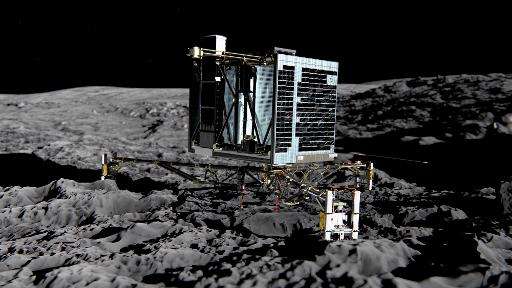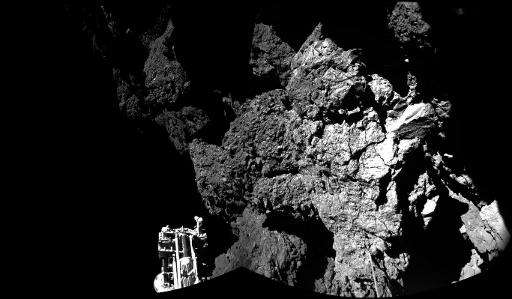Rosetta comet mission extended, dramatic climax seen (Update)

Europe on Tuesday announced its comet-chasing mission Rosetta would be extended until September 2016 and may end with the dying mothership touching down on the comet to be reunited with its tiny lander.
"The adventure continues," the European Space Agency (ESA) announced. "ESA's Science Programme Committee has given formal approval to continue the mission for an additional nine months."
In a final flourish to the historic mission, the Rosetta spacecraft may be "landed" on Comet 67P/Churyumov-Gerasimenko, the agency said.
Rosetta thus would rejoin its payload, the robot lab Philae, which it has nurtured throughout an odyssey spanning billions of kilometres.
"I may get to retire on the surface of 67P at end of my mission," the mothership tweeted. "But first I have a lot of exciting new science to do up here."
Launched in 2004, the mission has been applauded as a milestone in space exploration.
It comprises an orbiter and a lander, which seek to unveil the secrets of comets—primordial clusters of ice and dust that may shed light on how life developed on Earth.
One theory is that our infant planet was pounded by comets, which brought us precious gifts in the form of water and key biochemical molecules.
After a 10-year chase, the pair caught up with 67P last August.
In November, Philae was landed on the comet surface, and in a nail-biting 60-hour episode carried out a range of experiments before its stored battery power gave out.

But the plucky 100-kilo (220-pound) lander has now revived, thanks to sunlight bathing its solar panels as the comet zips closer to the Sun.
Both Rosetta and Philae will have a grandstand view when 67P reaches perihelion, its closest point to the Sun, on August 13, scientists hope.
The comet will then loop back into deep space, beginning another six-and-a-half-year trek around our star.
'Fantastic news'
Rosetta project scientist Matt Taylor said the mission extension was "fantastic news".
"We'll be able to monitor the decline in the comet's activity as we move away from the Sun again, and we'll have the opportunity to fly closer to the comet to continue collecting more unique data.
"By comparing detailed 'before and after' data, we'll have a much better understanding of how comets evolve during their lifetimes."
The mission had been nominally funded until the end of December 2015, and its extension was not a surprise.
By the end of September 2016, "as the comet moves far away from the Sun again, there will no longer be enough solar power to run Rosetta's set of scientific instrumentation efficiently," ESA said.
"At (this) point, the spacecraft will most likely be landed on the surface of Comet 67P/Churyumov-Gerasimenko."
The idea is to have Rosetta—which unlike Philae is not designed for a landing—spiral down to the comet over three months, using up its last drops of propellant to get unique close-ups of the surface.
"But there is still a lot to do to confirm that this end-of-mission scenario is possible," cautioned mission manager Patrick Martin.
"We'll first have to see what the status of the spacecraft is after perihelion and how well it is performing close to the comet, and later we will have to try and determine where on the surface we can have a touchdown."
As of Tuesday, Rosetta was 294,739,926 km (183,136,684 miles) from Earth, and 207,880,198 km from the Sun, according to ESA.
Since the launch from ESA's base in Kourou, French Guiana, the mission has travelled 7.015 billion km, the agency said on its website (sci.esa.int/where_is_rosetta/ ).
© 2015 AFP





















